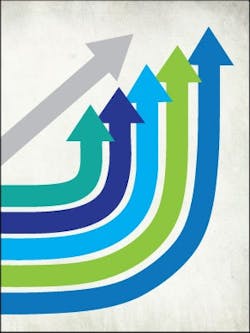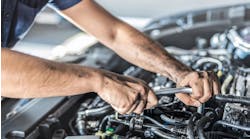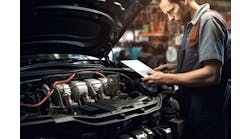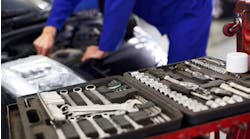It’s not about size, Tom Cummings says. The number of bays in your facility, the square footage, the number of technicians on staff—in the end, that’s not what’s going to define the success of your company.
“You have to be profitable,” Cummings says. “That’s all that matters.”
And to do that, he says, you have to be able to get the most out of every car that comes into your shop.
Cummings knows: His West Babylon, N.Y., location of Stack’s Auto Service and Tires, which he bought in 2004, does $1.6 million in annual sales with just three technicians working out of three bays. His second location, in North Babylon, does just north of $750,000 with two techs.
If you’re keeping score, that’s a $2.35-million-a-year operation that employs just five technicians.
And while Cummings tracks anything and everything that goes on in his business, one metric gets the lion’s share of his attention: average repair order (ARO).
ARO is one of the single most important numbers any shop can track, and improving it in your business is not only going to determine your profitability, but it also can be the difference between success and failure.
Cummings and two other shop owners shared their five best tips for increasing your shop’s ARO.
Tip No.1 Implement systems and procedures
The Idea: Mike Torres opened Dakota Ridge Complete Auto in Littleton, Colo., in 2008. From the time he opened his doors to today, he has helped his shop increase its ARO from barely $200 to consistently being above $450. And the first step was systemizing the operations in his facility.
“SOPs (standard operating procedures) are absolutely crucial to achieving a high ARO,” he says.
Each vehicle that comes into Torres’ shop receives a courtesy (and extensive) inspection. The process is detailed, in writing, for all of Torres’ staff, and that includes how to discuss it with the customer.
“We don’t do 30-minute oil changes; we’re not going to be a shop that tries to be the fastest,” he says. “We want to do the best job possible in diagnosing that vehicle. That’s the goal.”
How It Helps: You have to run a tight ship to achieve a high ARO, Cummings says. “There’s no way around it.” SOPs enable your shop to do that. They will help your staff to efficiently go about their work, allowing technicians to properly inspect vehicles and make quality repairs. It cuts down on comebacks and undiagnosed issues, and it will ensure that everything put on an estimate is necessary—and sellable.
Tip No.2 Have a consistent and efficient staff
The Idea: Find the right people, and put them in the right places. That’s pretty simple advice, says Scott Nolan, but it’s often something shops miss on.
Nolan, owner of Quality Auto Repair in Marlton, N.J., says the people you employ will make or break your ARO.
“You need professional, quality people in your shop, or any system or procedure you put in is just wasted,” he says.
It starts with fully understanding the role of each position in your facility, not only their daily tasks but also what type of person (in terms of skills and personality) aligns with that role. Written job descriptions are important, and once hired, regular review of performance and consistent training are vital to ensuring quality and efficient work.
How It Helps: Here’s where the “consistency” aspect of it comes in: The better your staff, the more consistent—and trustworthy—your service and offerings become to customers.
“Having the same people doing the same quality work again and again for customers builds trust,” says Torres, who had early issues with staff turnover. “Once we found a staff we could rely on, who were a good fit for our culture, and that are here for the long haul, we saw drastic improvements. People can trust the accuracy of the estimate when they trust the people giving it to them.”
Tip No.3 Keep Prices Steady and Accurate
The Idea: Choosing your prices can’t be a guessing game, and they shouldn’t be changing depending on customer’s needs, Cummings says. They need to be firm, and they need to account for the expenses of your business.
They also need to be high enough to ensure a high ARO.
“You can’t have a solid ARO without having accurate prices, and that means prices that are high enough,” he says.
Cummings set a labor rate ($109.75) to ensure a 70 percent gross profit on labor. He uses information providers to give “book time” for jobs to determine how many labor hours to charge. Then, he keeps parts pricing in line to achieve an average overall gross profit margin of 60 percent.
How It Helps: In it’s simplest explanation, higher prices equal higher ARO. But you need to balance prices with what customers will be willing to pay for jobs. Part of that, Torres says, comes from setting expectations when customers first come in.
“It’s the idea of under-promising and over-delivering,” he says.
Torres also sets up various payment and service options for customers, allowing them to complete non-safety-related issues in a series of visits, rather than all at once. That guarantees extra visits, and inspections, and helps to make sure all the work will be performed.
Also, Cummings suggests making sure to include regular maintenance and service as add-ons in your estimates, which help make the vehicle safer and give a boost to ARO.
Tip No.4 Improve Customer Service Equals Better Customer Demographics
The Idea: Nolan says customer service starts with what customers will see when they walk in. You don’t have to have the fanciest shop in your area, but you do need to exude a professional image, one that gives customers a reason to trust the quality of your work and the validity of your suggestions.
From there, Cummings says, the repair process needs to be as “painless as possible.” Cummings’ shop offers free shuttle service, and it picks up and delivers vehicles to customers as needed.
“What you’re doing is adding value to your service,” Cummings says.
And people take notice, Torres says. He lives within a few miles of his shop, and he sees his customers everywhere—from his lobby to the supermarket.
“We’re very involved in the community,” he says, “and it’s showing the customers that you’re on their side, not trying to take their money.”
How it Helps: Quality service delivers quality customers, Nolan says. Customers who care about their vehicles are the ones who will value strong customer service coupled with your thorough inspection and diagnosis processes.
“People wanting the cheap oil changes don’t care about all those other things; they’re there for price,” Torres says. “The service you’re providing attracts the people who want that type of service, which are usually conscientious customers who care about the vehicles, and will spend the money to keep them running safely.”
Those customers will be more inclined to have all the work done on an estimate, keeping the ticket price high.
Tip No.5 Relationship Selling
The Idea: Borrowing a phrase he learned from participating in RLO Training’s Bottom Line Impact Groups, Torres says it’s all about the “300 percent rule.”
“One hundred percent of your customers should be told 100 percent of what’s wrong with their vehicles 100 percent of the time,” he explains.
The concept is to give customers all available information that can help them make an informed decision of what to do with their vehicles. Cummings says his shop gives customers options for each repair, detailing what items need to be done, which are safety issues, and which ones can wait.
This can’t happen without an efficient inspection process, and it can’t be effective without creating a connection with that customer.
“It’s about building trust,” Cummings says. “If they see that you’re really looking out for their best interests, and not just making a sale, they trust what you’re telling them. By giving them options and information, and not trying to make the decision for them, you’re doing that.”
How It Helps: Well, you can’t have a solid ARO without being able to properly sell the work, Cummings says. “People get worried when they see higher prices or a whole list of work that needs to be done,” he says. “They might’ve just come in for some routine service, and it catches them off guard.”
Being able to relate well to the customer and demonstrate your respectable intentions helps in getting all the work sold, which keeps the ticket price up.
“ARO, in the end, comes down to being able to provide value through everything your shop does,” Cummings says. “That’s how you build trust, and that’s how your ARO gets higher. And that’s how your business will grow.”



